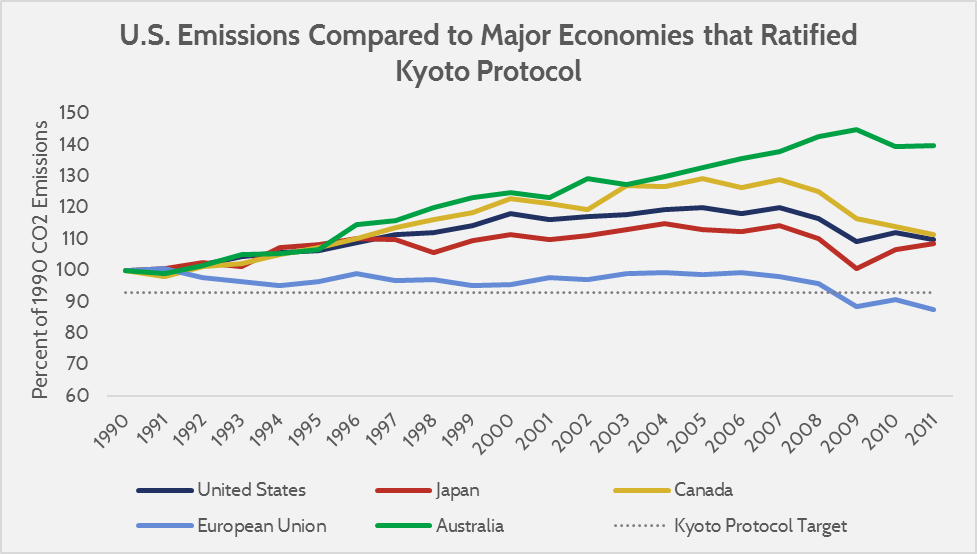Insight
April 25, 2016
America’s Earth Day Gift: Implications of the Paris Agreement
Summary
- The Paris Agreement is an international accord negotiated by 195 countries this past December to secure voluntary reductions in greenhouse gas (GHG) emissions. It will be open to signing on Earth Day (April 22nd), 2016.
- The Agreement does not specify how the U.S. should achieve its proposed targets. If America uses a regulatory approach the burden would be $38-45 billion/year. A market-based mechanism would likely be far cheaper.
- There are no penalties for non-compliance with the Agreement, and emission goals are voluntary. Compliance with the Agreement should not be the justification for adopting legally questionable regulation.
Introduction
This year’s Earth Day, the Paris Agreement—a global climate agreement negotiated by 195 countries—was opened to signing at the United Nations. The international accord marks the first global climate deal since the failed Kyoto Protocol. As President Obama is expected to sign the agreement, here is what Americans need to know.
Precursor to Paris
The Paris Agreement was intended to create a new global climate agreement to replace the Kyoto Protocol, which had been adopted in 1997 and failed to achieve its goals. The structure of the Kyoto Protocol was to place the burden of reducing GHG emissions on developed nations, while asking nothing of developing nations. President Clinton signed the Kyoto Protocol, but it was not ratified by Congress.
The structure of the Kyoto Protocol created heavy incentives for the biggest emitters to abstain, as they would bear the greatest burden of costs. However, major economies that ratified the Protocol and attempted to meet targets failed to do so (see graph below). The only economies that met original targets were those of the European Union, which used an emissions trading market.
 Source: World Bank. EU member emissions functioned as a bloc. Russia not included due to uniqueness of Soviet Union collapse.
Source: World Bank. EU member emissions functioned as a bloc. Russia not included due to uniqueness of Soviet Union collapse.
Despite the harsh penalties for failure under the Kyoto Protocol, obligated parties were either unwilling or unable to meet their targets. The upshot is that there is little hope of an enforceable global agreement to regulate emissions as was originally envisioned by environmentalists and other proponents of the Kyoto Protocol.
Change Course to Paris
In 2009 it was clear that the prisoner’s dilemma of global emissions could not be so easily dismissed. Work began on a new agreement, which after years of negotiation culminated in 2015’s “Paris Agreement.” Unlike the Kyoto Protocol, national emission targets are voluntary “contributions” to the global total, and enforcement provisions are extremely lax.
Prior to the negotiations that occurred last December, over 160 participating nations submitted their “intended nationally determined contributions,” (INDCs), outlining their plans to reduce GHG emissions. The objective of the Paris Agreement is to monitor participating states on their progress with their INDCs, and call attention to states that fail to comply with their own INDCs. To avoid states withdrawing from participation, there are no penalties for non-compliance. The only recourse for dealing with states that are found to be non-compliant is for them to establish new INDCs to return to compliance.
The Paris Agreement trades away ambitious targets for ambitious participation, doubling down on inclusivity. Even though the collective INDCs are expected to fall short of the Paris Agreement’s emission goals, it establishes norms, standardizes emission metrics, and creates transparency that sets a tone for how the international community approaches climate issues.
The Chicken and the Egg
America’s submitted INDC proposes reducing GHG emissions by 26-28 percent of 2005 levels by 2025. Research from the American Action Forum shows that current GHG regulatory burdens are around $26 billion annually. Achieving the INDC target via regulation would increase this burden by up to $45 billion per year. Achieving America’s INDC, as envisioned by the administration, would be costly.
America’s INDC is not an imposed target by the international community though; it is a voluntary target set by the administration which is reflective of expected emission reductions under the proposed policies of the “Climate Action Plan.” This means the regulation and targets came long before the Paris Agreement, and it would be poor policy to use compliance with an international agreement to prop up questionable regulatory policies, such as the Clean Power Plan that was stayed by the Supreme Court. Regulations are supposed to help us meet set goals, goals aren’t supposed to be set to help regulations.
Furthermore, neither the Paris Agreement nor the INDC at all specify that targets must be met through regulation. In theory, America could meet its INDC target using market based incentives for cutting emissions (like a carbon tax), and then cut back regulatory burdens. However, since there is no penalty for failing to meet targets, compliance with the Agreement should not be the primary concern for developing American energy policy anyway.
Conclusion
The Paris Agreement should not be conflated with the administration’s regulatory policies, which came prior to the U.S.’ proposed emission reductions for its INDC. If America falls out of compliance, there is no penalty for failure, so the Agreement should not be used as a reason to excuse regulation from scrutiny.










